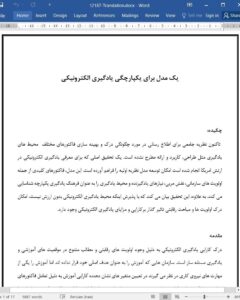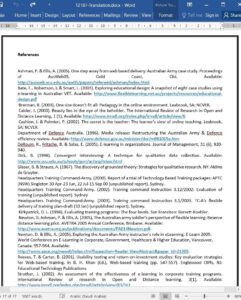Abstract
As yet there is no comprehensive theory to inform how the various elements of elearning environments, such as design, implementation and delivery can be understood and optimised. A major study of the introduction of e-learning into the Australian Army has allowed a preliminary grounded theory model to be developed. This model identifies key factors, including organisational priorities, instructors’ roles, learners’ needs and the learning environment as contributing to an integrated e-learning culture. Furthermore, the study highlights that by accepting that e-learning environments are not value-free, it is possible to understand the competing priorities and discourses that influence how e-learning effectiveness is constructed and defined.
Introduction
Understanding e-learning effectiveness is problematic and contested due to the wide range of competing priorities and discourses across a range of education and training situations. Organisations which do not have training as their main purpose but rely on training to maintain a skilled and competent workforce have added difficulties in determining the variables that reflect training effectiveness due to the interactions of organisational, technological and learning factors. A recent literature review of e-learning effectiveness in workplace organisations (DeRouin, Fritzche, & Salas, 2005) also identified significant gaps, including the limited research available, the time lag between research and practice and inconsistencies in research approaches.
Conclusions
This study has provided a model grounded in the experiences of e-learning participants in a large workplace organisation. It was found that decisions influencing e-learning in an organisation reflected implicit and explicit features of the organisational culture. An integrated e-learning culture developed by balancing expectations from the organisational culture with experiences of e-learning. Therefore, it is necessary to understand the interactions between organisational priorities, learners’ needs, instructors’ roles and the learning environment to inform the discussion and conceptualisation of effective e-learning. By taking the approach that the e-learning environment is not value free it is possible to understand the competing priorities and discourses that influence how e-learning effectiveness is constructed and defined. Therefore, this study informs some of the gaps identified in the e-learning effectiveness literature which were summarised by Derouin et al (2005), including: “…we are aware of no theory that has been the major influence in the design, delivery, and implementation of e-learning systems” (p. 934); “And much remains to be learnt about how to best design the e-learning environment, how to optimise its delivery, and what works when and why” (p. 937). Further research will review this model in relation to the broader literature and experiences in other organisations to further extend and refine the concept of developing an integrated e-learning culture.











